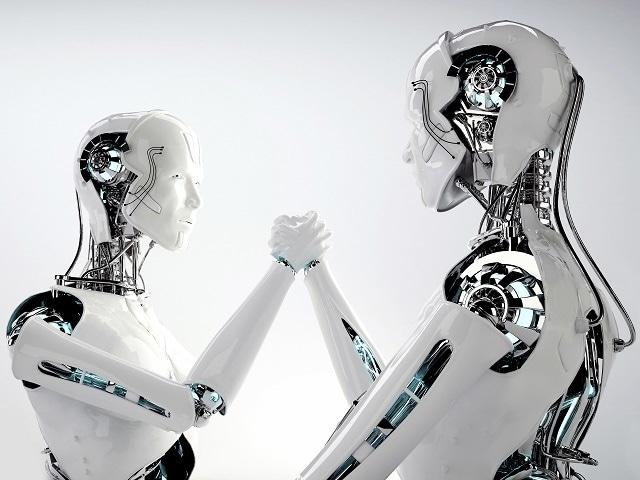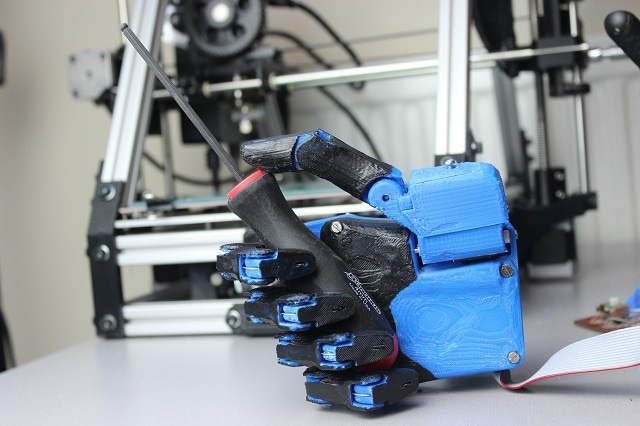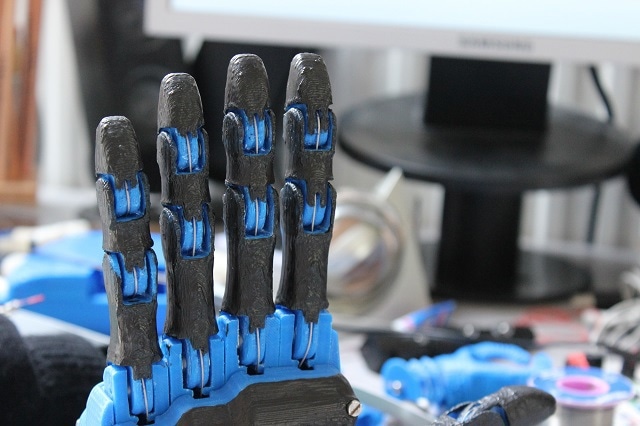Jul 7 2014

Image Credit: Thinkstock
Traditionally, one of the most challenging areas of robotics has been the ability to successfully emulate human behaviour. Now, products like the 'Dextrus' hand from the Open Hand Project may mean low cost, intuitive robotic hands are within reach.
The Open Hand Project
Joel Gibbard established the ‘Open Hand Project’ in 2013 with the aim of developing his robotic hand.
Based on his final year project in robotics from the University of Plymouth, the prosthetic hand is designed as a low cost robotic device for upper limb amputees.
Engineered for Functionality
The Dextrus hand, as it’s names suggests, has been engineered with functionality in mind. All of the electronics and motors are fitted inside the palm of the hand which means it can accommodate a range of amputees.
The Dextrus hand can be fitted to existing prosthetics with no need for custom fittings. It uses an intuitive control system incorporating two EMG sensors which can be placed on any muscle. The Dextrus hand also allows the user to create their own custom control hardware by using the documented serial communication interface.

Image Credit: Open Hand Project
A Tough Alternative at a Fraction of the Cost
Traditional prosthetic hands are made from expensive materials such as titanium and carbon fiber. These materials allow the user to consistently use the product with very little wear. However, the Dextrus hand takes advantage of low cost materials such as ABS plastic which offer a tough alternative at a fraction of the cost.
The plastic components are manufactured using 3D printers which further reduce the cost for the end user and also allow for a quick and easy replacement of any broken parts.
A single tendon runs through all of the joints in the hand and allows Dextrus to grasp just like a human hand, adapting to accommodate different objects. The tendons are made from a marine grade stainless steel which has a minimum breaking load of 18Kg per finger. The stainless steel tendons are also coated in nylon to ensure they move smoothly throughout the joints.
The Dextrus hand is designed for everyday use however, like with most manmade objects, it’s subject to fatigue. To help maximize the life of the joints, the tendons are held taught by a compression spring assembly. This means that if the user knocks one of the fingers by accident, the compression spring will flex allowing the finger to move and then return to its original position.

Image Credit: Open Hand Project
Feedback sensors allow the hand to know exactly how hard it is gripping an object. The gripping motion is achieved using miniature, epicyclic geared motors which allow for a fine grip to grasp delicate objects, but enough pressure to hold heavier objects you may find around the house.
Testing of the Dextrus hand suggests that it will operate for around 8-12 hours on a single charge with traditional lithium ion batteries.
The Open Hand Project aims to make advanced prosthetics hands more accessible to amputees. It is also an open-source project, meaning anyone can use the technology to make their own version which will help in distributing these devices to amputees living in developing countries
There are more developments in the pipeline. After developing a working device, the next move will be to try and custom fit it using 3D scanning and 3D printing. After that I aim to bring the cost down even further and create a smaller hands for children. After that... who knows!?
Joel Gibbard - Open Hand Project
Other robotic hand technology has sought to take a truly anthropomorphic approach to robot manipulation. The Shadow Dexterous hand has 20 actuated degrees of freedom, position and force sensors, and ultra-sensitive touch sensor on the fingertips.
The hand is designed to provide a solution for problems that require the closest approximation of the human hand possible with today’s technology.
Looking to the Future
Robotics technology may offer amputee’s a new way of regaining most of their previous dexterity. Products like 'Dextrus' are allowing for a more inclusive environment and are also offering a helping hand in the development of this technology.
Whether we see other companies following in the footsteps of this project remains to be seen, but it’s clear that this technology is moving quickly and the industry is working hard to produce a product which conclusively emulates human behaviour.
References